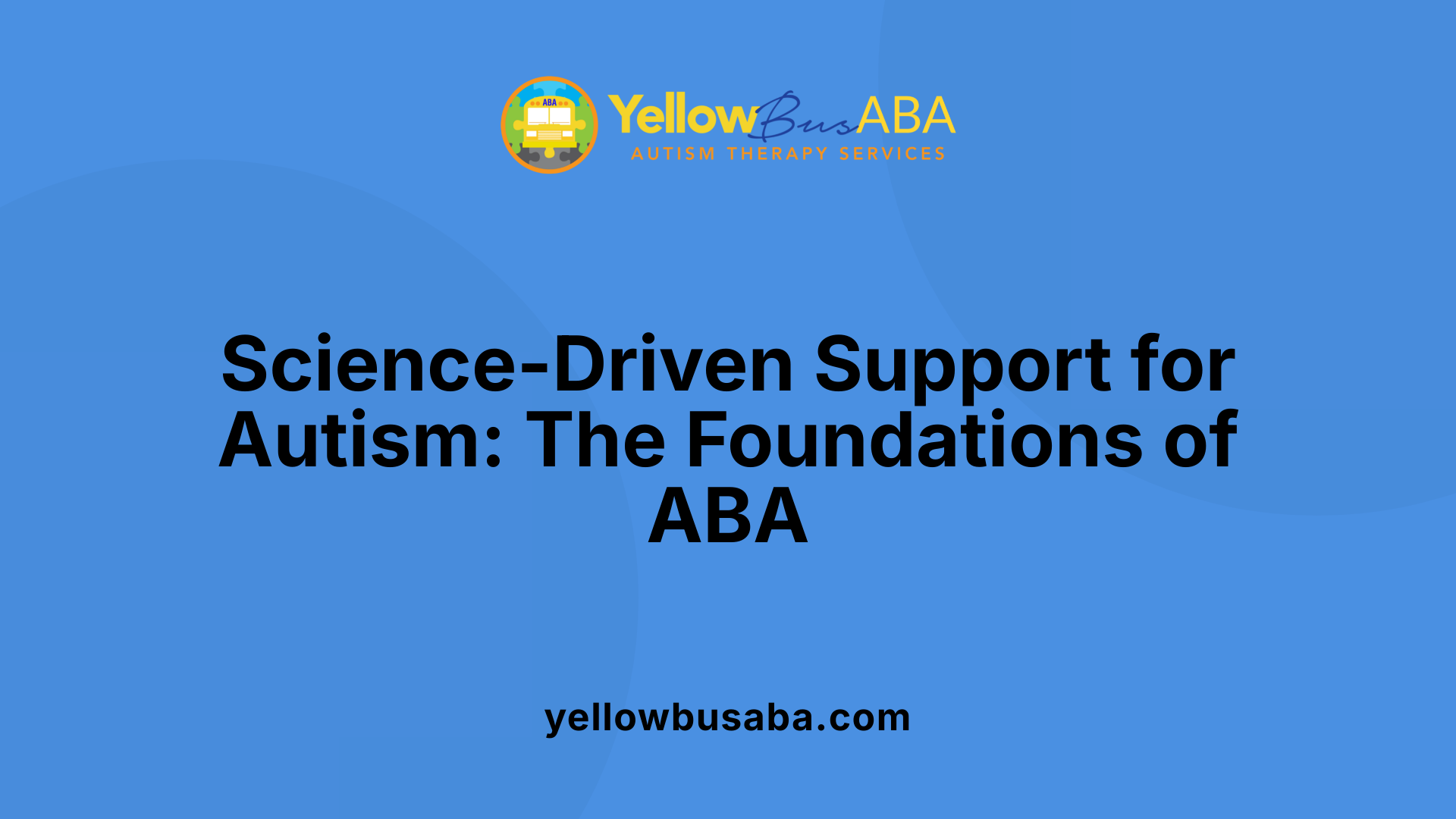How to Manage Behavior Challenges in Public Settings with ABA Strategies
October 29, 2025
Effective ABA Strategies for Navigating Public Behavior Challenges

Understanding ABA and Its Role in Autism Support
Applied Behavior Analysis (ABA) therapy is a scientifically grounded approach designed to support individuals with autism by developing essential skills and managing challenging behaviors. This article explores how ABA techniques can be employed specifically to manage behavior challenges in public settings, offering practical insights for families, caregivers, and professionals. Through tailored interventions, positive reinforcement, and collaborative support, ABA empowers children with autism to navigate public environments more successfully and confidently.
The Foundations of ABA Therapy: Science-Backed Support for Autism

What is Applied Behavior Analysis (ABA) therapy and how is it used for individuals with autism?
Applied Behavior Analysis (ABA) therapy is a science-based approach designed to help individuals with autism spectrum disorder (ASD) develop essential skills while reducing challenging behaviors. It uses principles from behavior science to break down complex skills into smaller, manageable tasks that can be taught and reinforced systematically. ABA programs are highly individualized, focusing on each person's unique developmental needs.
Professionals trained in ABA, such as board-certified behavior analysts (BCBAs) and registered behavior technicians (RBTs), deliver therapy through structured and naturalistic settings like the home, school, or community. The therapy targets behaviors important for daily living, including communication, social interaction, self-care, and academic skills, by encouraging positive behaviors and reducing harmful or interfering ones.
Core ABA principles: positive reinforcement and behavioral analysis
ABA is grounded in the understanding that behavior is influenced by environmental factors and shaped by its consequences. The therapy relies heavily on positive reinforcement—rewarding desired behaviors to increase their occurrence. The ABC model (Antecedent-Behavior-Consequence) is used to analyze what triggers behaviors and the results that maintain them.
Techniques include discrete trial training (DTT), natural environment teaching (NET), modeling, prompting, and fading of assistance. These methods help teach new skills and replace problematic behaviors with functional alternatives. ABA also employs detailed data collection and assessment to monitor progress and adjust interventions accordingly.
The scientific and individualized nature of ABA
ABA is a widely researched, evidence-based intervention recognized by institutions like the American Psychological Association. Its foundation in behavioral science ensures that strategies are systematic and measurable. Individualized treatment plans stem from thorough assessments identifying each child's skill levels and behavioral challenges.
This personalized approach enables ABA to address multiple skill domains such as communication, socialization, academic abilities, and activities of daily living (ADLs). Early intervention with ABA correlates with better outcomes, including improved independence and quality of life.
Overall, ABA therapy offers a structured, flexible, and scientifically supported framework that empowers individuals with autism to achieve meaningful, lasting progress.
Who Provides ABA Therapy? Professional Qualifications and Roles

Credentials and qualifications of ABA therapists
ABA therapy is delivered by licensed and certified professionals who have specialized education and training in behavior analysis and developmental disorders. The most recognized credential is the Board Certified Behavior Analyst (BCBA), requiring at least a master's degree in psychology, education, behavior analysis, or related fields, completion of supervised practical experience, and passing a rigorous national examination. Licensed Behavior Analysts (LBAs) also hold similar qualifications depending on state licensure requirements. Certified Behavior Analyst Assistants (CBAAs) usually hold a bachelor’s degree and receive specific training to support interventions under direct supervision.
Roles of BCBAs, LBAs, CBAAs, and other providers
BCBAs and LBAs are responsible for conducting functional behavior assessments, designing individualized treatment plans, and supervising therapy implementation. They ensure that interventions are data-driven and tailored to the unique needs of each client. CBAAs and other trained therapists implement prescribed teaching strategies, conduct daily sessions, and collect progress data, all while operating under the guidance of a BCBA or LBA.
Importance of supervision and ethical standards
Supervision is a critical component to maintain the quality and integrity of ABA therapy. Licensed professionals oversee assistants and technicians to ensure adherence to ethical guidelines established by bodies such as the Behavior Analyst Certification Board (BACB). Maintaining confidentiality, applying evidence-based methods, and ensuring client welfare are fundamental ethical standards in ABA service provision.
Settings where ABA therapy is provided
ABA therapy is versatile and administered in a variety of environments including homes, schools, specialized clinics, and community settings. Providers often adapt therapy to fit the individual's daily life context, promoting generalization and functional skill development across settings. Specialized companies and programs may offer comprehensive ABA services combining clinical expertise with behavioral support in real-life situations.
Tailoring ABA Programs: Individualized Approaches for Behavior Management
How is an ABA therapy program tailored to meet the needs of each individual?
ABA therapy programs begin with a detailed assessment process that includes functional behavior assessments (FBAs), direct observations, and caregiver interviews. These evaluations identify the specific causes and functions of behaviors using the ABC model—analyzing Antecedents (triggers), Behavior itself, and Consequences. This analysis helps therapists understand what drives behaviors so they can create targeted interventions.
Individualized treatment plans are then developed based on the person’s unique strengths, challenges, interests, and cultural background. These plans focus on meaningful and socially significant goals such as communication, social skills, or daily living activities. Personal preferences are considered to increase motivation and promote engagement throughout therapy.
Data collection plays a critical role in tailoring ABA interventions. Therapists continuously monitor progress through systematic tracking tools and training records, allowing them to make informed decisions to adjust strategies for maximum effectiveness. This dynamic process encourages flexibility to meet evolving needs.
Families and caregivers are actively involved to support generalization of skills across settings like home, school, and community. Additionally, cultural sensitivity is prioritized to ensure that interventions respect and incorporate diverse backgrounds.
Through these tailored and evidence-based approaches, ABA therapy supports behavior management in a way that is individualized, adaptive, and respectful of each person’s unique profile.
Practical ABA Strategies for Managing Challenging Behaviors in Public
What are common ABA techniques used in public settings?
ABA employs several effective techniques to manage challenging behaviors in public, including positive reinforcement, prompting, fading, and chaining. Positive reinforcement encourages desired behaviors by providing rewards or praise. Prompting involves giving support or cues to initiate behavior, which is gradually reduced during fading to promote independence. Chaining breaks complex tasks into smaller steps that are taught sequentially, helping children complete behaviors successfully.
How do visual aids, scripting, and task analysis help in public?
Visual aids like schedules and modeling videos provide clear expectations and guidance, making unfamiliar public settings easier to navigate. Scripting offers children rehearsed phrases or actions to use in social situations, reducing anxiety and improving communication. Task analysis breaks down public routines into manageable steps, allowing children to learn and perform behaviors systematically.
What self-regulation and emotional coping strategies are taught?
ABA teaches self-regulation through strategies such as self-monitoring and deep breathing exercises to help children recognize and manage their emotions. Personalized coping techniques, like positive self-talk, equip children with tools to handle frustration or overstimulation during public outings.
How is skill generalization ensured across environments?
ABA emphasizes generalization, meaning skills learned during therapy are practiced and reinforced in real-world settings like public places. Involving caregivers and creating consistent reinforcement systems across environments help children apply behaviors spontaneously and appropriately outside of therapy.
What examples of reinforcement systems work well in public?
Effective public reinforcement includes tangible rewards like small toys or treats, social praise from caregivers or therapists, and token systems where children earn points toward a preferred activity. These systems are tailored to each child's preferences to motivate positive behavior consistently during public activities.
These practical ABA strategies provide structured, individualized approaches for managing challenging behaviors in public, fostering independence and positive social interactions for children with autism.
Supporting ABA Therapy Outside Sessions: Role of Families and Caregivers

How can families and caregivers support someone undergoing ABA therapy?
Families and caregivers play a crucial role in supporting ABA therapy by ensuring consistent reinforcement of skills across settings. Close collaboration with therapists allows caregivers to understand individualized behavior plans and apply strategies effectively during daily routines and public outings. This consistency helps children generalize skills learned in therapy to real-life environments.
Incorporating ABA principles at home includes maintaining structured schedules, using visual supports like schedules and task analyses, and providing positive reinforcement such as praise or small rewards for desired behaviors. Creating a predictable and positive environment encourages children to practice new skills confidently.
Family training and education on ABA empower caregivers to understand the therapy’s methods, making them active participants in the intervention process. Attending workshops and ongoing communication with professionals enhances their ability to use prompting, reinforcement, and behavior management techniques effectively.
Through active involvement, caregivers support skill generalization—ensuring that improvements in communication, social interactions, and daily living skills are maintained over time. Their participation also helps track progress, informs treatment adjustments, and sustains motivation for continuous development outside therapy sessions.
Enhancing Independence and Confidence Through ABA in Public Settings
Successfully managing challenging behaviors in public with ABA strategies requires personalized, evidence-based approaches delivered by qualified professionals and supported by committed families and caregivers. Through systematic assessments, tailored interventions, and consistent reinforcement, ABA therapy helps individuals with autism build communication, social, and self-regulation skills essential for navigating public environments. The collaborative efforts of therapists and families foster skill generalization and independence, leading to improved quality of life and greater social participation. By understanding and applying ABA principles, families can create supportive experiences that empower children with autism to thrive beyond therapy settings and confidently engage with their communities.
References
- Effective ABA Techniques for Managing Challenging Behaviors
- Applied behavioral analysis for the skill performance ...
- 5 Ways ABA Therapy Helps with Classroom Adaptations
- ABA Therapy Examples, Definition & Techniques
- Applied Behavior Analysis - Florida Autism Charter School ...
- Applied Behavior Analysis (ABA)
- Applied Behavior Analysis (ABA)
- Applied Behavior Analysis in Children and Youth with ...





.jpg)
